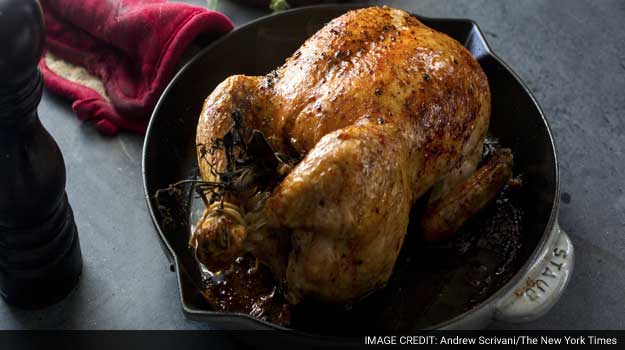There are hundreds of ways to roast a chicken. This is one of the easiest and best.There’s nothing new about it; it’s as classic as roast chicken recipes come. And if you’ve ever roasted a chicken, you’ve probably made something pretty much like it.Maybe I call for a little more salt than you’re used to, and a lot more pepper. And perhaps I roast this at a slightly higher temperature than you do. Roasting a chicken is not an exact science. There are plenty of ways to get that golden iconic bird on your dinner table. That said, there are some general roast-chicken best practices that you can apply to whatever method you like.
The first is to seek out a good-quality bird. Whether you buy it at the butcher, farmers’ market or supermarket, and whether you choose organic, air-chilled or antibiotic-free, the better the bird tastes from the get-go, the less you have to do on your end.Always salt the chicken ahead if you have time. Even an hour makes a difference, giving the salt a chance to form a brine that can get at least somewhat absorbed into the flesh. If you can salt the chicken the day before, even better. Leave it uncovered in the fridge so the skin can dry out a bit. This gives you a crisper, more burnished result.Then there is the question of seasoning. Other than salt and pepper, I like to use herbs. They are optional, but they lend a subtle perfume. Twiggy herbs like rosemary, bay leaves and thyme will release less moisture into the chicken’s cavity than softer herbs such as basil and parsley, which in turn may give you a slightly crisper skin. Ditto ribbons of lemon peel, rather than juicy lemon halves, if you like a lemon-tinged bird.As for the age-old question of trussing, it is purely a matter of preference. Trussing makes for a nice-looking, compact and easy-to-maneuver bird. But I’ve found no real difference in how the chicken roasts. So truss or don’t as you see fit. When in doubt, take the easy way.The most important thing with roast chicken is to find a go-to method when you want a guaranteed result. Then feel free to mix it up (spatchcocking, splaying and the like) when you’re in the mood to play. In the end, a delicious dinner is the only thing that counts.Recipe:Salt-and-Pepper Roast Chicken1 (3 1/2-pound) whole chicken, patted dry2 1/2 teaspoons kosher salt2 teaspoons black pepperSmall bunch mixed herbs, such as rosemary, thyme and sage1. Season the chicken inside and out with salt and pepper. If you have time, refrigerate the chicken, uncovered, for an hour, or overnight.2. Heat oven to 450 degrees. Place chicken breast-side up in a roasting pan or large ovenproof skillet. Stuff cavity with herbs and tie the legs together with kitchen twine. (If you don’t have twine, leave the legs as they are.)3. Roast 50 minutes, then baste chicken with pan juices. Continue roasting until chicken’s juices run clear when skin is pierced with a knife, 5 to 10 minutes longer. Let stand 10 minutes before carving.Sidebar:And to Drink ...Roast chicken with almost any wine is a great combination, from the most modest of bottles to the greatest. Adding a forceful sauce helps to focus the options. For aioli, I would veer toward fresh young whites, like a good Verdicchio or Etna Bianco, a Sancerre or even a Provençal rosé. A rich béarnaise demands something more substantial, like a good Meursault or rich chardonnay, or even a New World pinot noir. For a spicy salsa verde, I may retreat to the fresh whites, or try a modestly sweet wine like a German spätlese riesling or a demi-sec Vouvray. For the nutlike, spicy romesco, a fino sherry would be lovely. You could also stick with chardonnay, or try Champagne. Chimichurri would go with the fresh whites, an open and inviting red from the northern Rhône or a good New World syrah. With gravy, any wine you like, white or red.
© 2015 The New York Times News Service
The first is to seek out a good-quality bird. Whether you buy it at the butcher, farmers’ market or supermarket, and whether you choose organic, air-chilled or antibiotic-free, the better the bird tastes from the get-go, the less you have to do on your end.Always salt the chicken ahead if you have time. Even an hour makes a difference, giving the salt a chance to form a brine that can get at least somewhat absorbed into the flesh. If you can salt the chicken the day before, even better. Leave it uncovered in the fridge so the skin can dry out a bit. This gives you a crisper, more burnished result.Then there is the question of seasoning. Other than salt and pepper, I like to use herbs. They are optional, but they lend a subtle perfume. Twiggy herbs like rosemary, bay leaves and thyme will release less moisture into the chicken’s cavity than softer herbs such as basil and parsley, which in turn may give you a slightly crisper skin. Ditto ribbons of lemon peel, rather than juicy lemon halves, if you like a lemon-tinged bird.As for the age-old question of trussing, it is purely a matter of preference. Trussing makes for a nice-looking, compact and easy-to-maneuver bird. But I’ve found no real difference in how the chicken roasts. So truss or don’t as you see fit. When in doubt, take the easy way.The most important thing with roast chicken is to find a go-to method when you want a guaranteed result. Then feel free to mix it up (spatchcocking, splaying and the like) when you’re in the mood to play. In the end, a delicious dinner is the only thing that counts.Recipe:Salt-and-Pepper Roast Chicken1 (3 1/2-pound) whole chicken, patted dry2 1/2 teaspoons kosher salt2 teaspoons black pepperSmall bunch mixed herbs, such as rosemary, thyme and sage1. Season the chicken inside and out with salt and pepper. If you have time, refrigerate the chicken, uncovered, for an hour, or overnight.2. Heat oven to 450 degrees. Place chicken breast-side up in a roasting pan or large ovenproof skillet. Stuff cavity with herbs and tie the legs together with kitchen twine. (If you don’t have twine, leave the legs as they are.)3. Roast 50 minutes, then baste chicken with pan juices. Continue roasting until chicken’s juices run clear when skin is pierced with a knife, 5 to 10 minutes longer. Let stand 10 minutes before carving.Sidebar:And to Drink ...Roast chicken with almost any wine is a great combination, from the most modest of bottles to the greatest. Adding a forceful sauce helps to focus the options. For aioli, I would veer toward fresh young whites, like a good Verdicchio or Etna Bianco, a Sancerre or even a Provençal rosé. A rich béarnaise demands something more substantial, like a good Meursault or rich chardonnay, or even a New World pinot noir. For a spicy salsa verde, I may retreat to the fresh whites, or try a modestly sweet wine like a German spätlese riesling or a demi-sec Vouvray. For the nutlike, spicy romesco, a fino sherry would be lovely. You could also stick with chardonnay, or try Champagne. Chimichurri would go with the fresh whites, an open and inviting red from the northern Rhône or a good New World syrah. With gravy, any wine you like, white or red.
© 2015 The New York Times News Service
Advertisement








